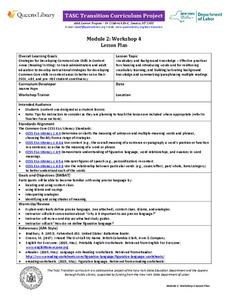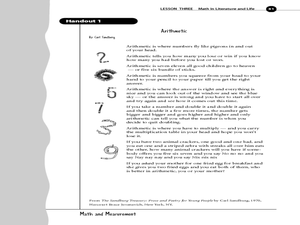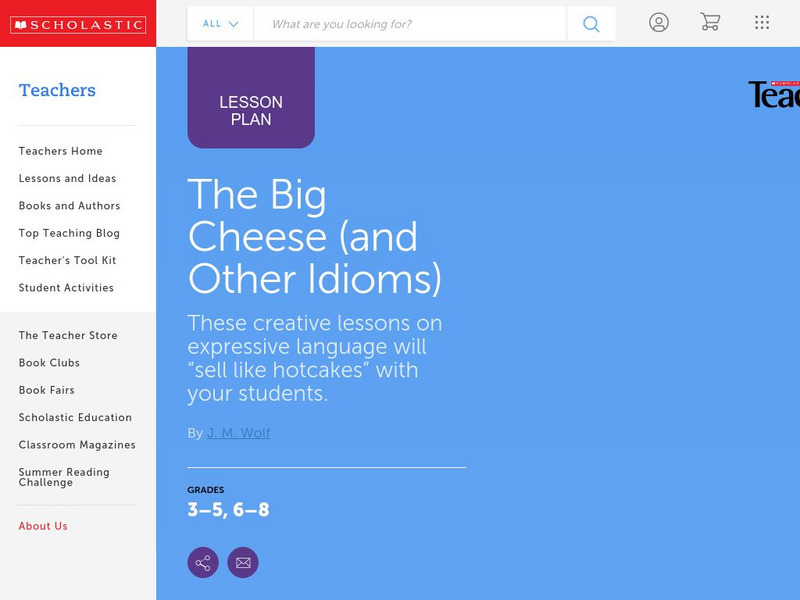Curated OER
You Don't Say!!
Fourth graders write and respond to sayings throughout the school year. They define the idioms, illustrate them and compare their meanings with other groups in the class.
Curated OER
A Lucky Break
Students complete activities where they identify and decipher common phrases that are related to poultry and then cook drumsticks as a class. In this poultry lesson plan, students also read the history of the chicken and create idioms.
Curated OER
A Lucky Break
Explore idioms with a chicken theme! Consider doing these activities prior to Thanksgiving, as there's a section about wishbones! First your youngsters will match a short list of idioms with their meanings. Then, give each learner the...
EngageNY
Conducting Research: Analyzing a Variety of Sources to Capture Information about My Insect
From picture to words. Scholars analyze a picture of an ant and then list two facts they observed and any questions that may arise. Expert groups from the previous instructional activity then look at a diagram about either an ant or...
Curated OER
This is Straight From The Horse's Mouth
Eighth graders use a PowerPoint presentation to explore the history of idioms, how they are used in our language today, and practice using idioms themselves. After the presentation, each student is given an idiom to research.
Curated OER
Norse Mythology
Third graders read several selections of Norse mythology and compare this mythology to others studied in the past. They are introduced to runes. They read poetry and compile a class book of favorite poems. They define idioms and cite...
New York State Education Department
TASC Transition Curriculum: Workshop 4
Why is it important to use precise language? Participants explore this question in the fourth activity in a series of 15 on effective instruction. Perfect for all content areas, the activity promotes appropriate language choice through...
Curated OER
Flora and Fauna as Figures of Speech
What a lovely way to incorporate artwork into your language arts lesson. View artwork in illustrated manuscript pages, depicting insects, animals, plants, flowers, and ornate writing in the Getty Museum. Practice using figurative...
August House
The Clever Monkey Rides Again
Use a West African folktale to practice several different skills in your first grade classroom. Learners read The Clever Monkey Rides Again and focus on rhyming words, reading comprehension, measurement, art, movement, and word order.
Curated OER
Electrifying Franklin
Fourth graders research and present information about Benjamin Franklin's life and accomplishments. For this lesson on Benjamin Franklin, 4th graders review idioms and sayings written by Franklin then compare and contrast his various...
Curated OER
Editorial Cartoons: Gay Rights
Students consider gay rights. In this editorial cartoon lesson, students analyze an editorial cartoon by identifying the idioms and puns in the cartoon. Students create their own editorial cartoons.
Curated OER
Editorial Cartoon: Equal Opportunity
learners explore how editorial cartoons often use familiar adages or idioms in new ways to make a point about something.
Curated OER
Language and Dialect
Practice listening skills while studying oral story tellers from different parts of Louisiana. Consider the regional dialects and insider language of folk groups with your class. Identify language as part of folk life and recognize that...
Curated OER
Proverbs
Fifth graders listen to a fable that ends with a proverb. They infer the meaning of the proverb. Students examine proverbs and predict meaning. They write a skit that shows the appropriate usage of the proverb.
Curated OER
Math in Literature and Life
Pupils read poems, read phrases, and create a poster for what math is and relate it back to literature. They also discuss the impact math has had on literature.
Curated OER
Documentarians of an Era: A Study of the Paintings of Thomas Eakins and Gustave Caillebotte
Young scholars produce an object analysis of 'The Champion Single Scull'. They begin with description, proceeding to deduction, and finally providing speculation by interpreting the outward evidence of culture. They use a clipboard and...
Curated OER
Tall Tales and Urban Legends
Students identify and interpret what tall tales, urban legends, and cyberlore are and to find them in their own lives. They practice telling and listening to these types of tales and explore why people tell them. Students also identify...
Pennsylvania Department of Education
Storybooks and Games
Students explore stories, games and coloring pages on an interactive website. In this pre-reading activity, students have free access to stories, coloring pages and simple games at the Lil' Fingers website.
Better Lesson
Better Lesson: L.4.5b: Recognize Meanings of Idioms, Adages, Proverbs
Links to 10 lessons and activities that build student skills in standard L.4.5b: Recognize and explain the meaning of common idioms, adages, and proverbs.
Scholastic
Scholastic: The Big Cheese and Other Idioms
Find out more about idioms through this informative resource. This site provides activities and ideas revolving around sharpening your knowledge of idioms.
Broward Education Foundation
Broward Education Foundation: Using Idioms Is a Piece of Cake [Pdf]
Teaching about idioms can be great fun. Why are idioms important? Idioms are important so that young scholars can understand what everyone is saying! Idioms are a part of the figurative language. Using the Literal language (as in saying...






















![Broward Education Foundation: Using Idioms Is a Piece of Cake [Pdf] Lesson Plan Broward Education Foundation: Using Idioms Is a Piece of Cake [Pdf] Lesson Plan](https://d15y2dacu3jp90.cloudfront.net/images/attachment_defaults/resource/large/FPO-knovation.png)